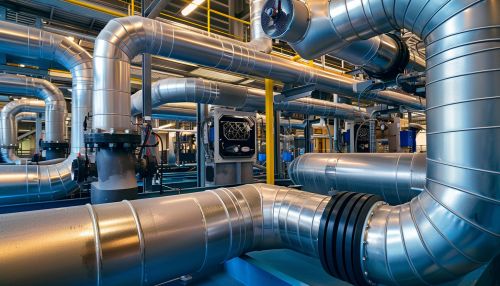Cooling system
Overview
A cooling system is a mechanism that dissipates heat from a process or system to maintain the process or system at a safe operating temperature. The cooling process can be achieved through various methods, including heat transfer, thermodynamics, and fluid dynamics. Cooling systems are essential in many industries, including automotive, computer, and power generation.


Types of Cooling Systems
There are several types of cooling systems, each with its unique characteristics and applications. These include:
Air Cooling
Air cooling is a method of dissipating heat by exposing the heated surface to air. This method is commonly used in small engines and personal computers. The heat is transferred from the heated surface to the air through convection.
Liquid Cooling
Liquid cooling involves the use of a liquid, typically water or a specialized coolant, to absorb and dissipate heat. This method is often used in high-performance computers and automotive engines. The heat is transferred from the heated surface to the liquid through conduction.
Phase Change Cooling
Phase change cooling involves the use of a substance that changes its state from a liquid to a gas to absorb heat. This method is used in refrigeration and air conditioning systems. The heat is absorbed during the phase change process.
Components of a Cooling System
A typical cooling system consists of several components, each playing a crucial role in the heat dissipation process. These include:
Coolant
The coolant is the substance that absorbs heat from the system or process. It can be a liquid, such as water or a specialized coolant, or a gas, such as air.
Pump
The pump circulates the coolant through the system. It ensures that the coolant is continuously moving, allowing it to absorb and dissipate heat effectively.
Heat Exchanger
The heat exchanger is where the heat transfer occurs. It is designed to maximize the surface area in contact with the coolant to facilitate efficient heat transfer.
Radiator
The radiator is where the heat is dissipated to the surrounding environment. It is typically designed with fins to increase the surface area for effective heat dissipation.
Applications of Cooling Systems
Cooling systems are used in a wide range of applications, including:
Automotive
In the automotive industry, cooling systems are used to maintain the engine at a safe operating temperature. This is crucial to prevent overheating, which can cause severe damage to the engine.
Computer
In computer systems, cooling systems are used to dissipate heat generated by the processor and other components. This is essential to prevent thermal throttling, which can reduce the performance of the computer.
Power Generation
In power generation, cooling systems are used to dissipate heat generated during the power generation process. This is crucial to maintain the efficiency and safety of the power plant.
